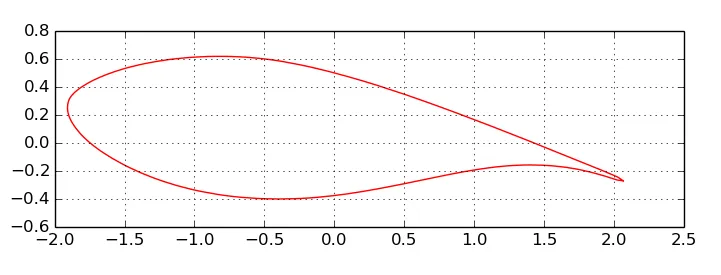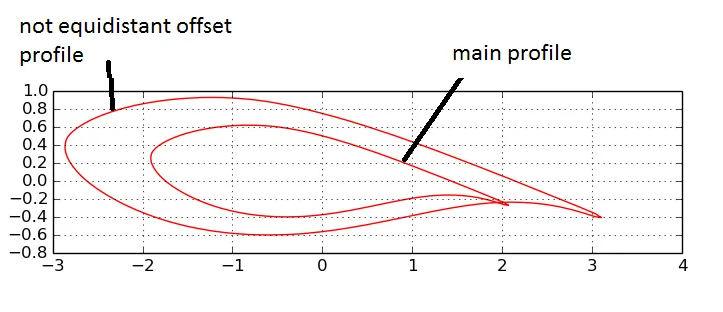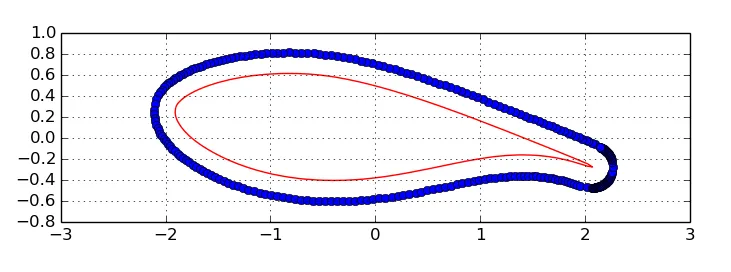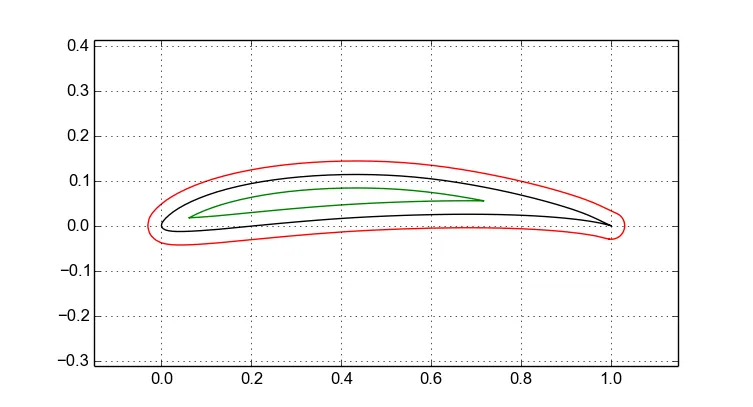如何从点的X,Y列表和偏移距离中获取偏移样条线的X,Y坐标
7
- efirvida
13
@IlyaPeterov 曲线以x,y坐标存储在np.array中,我不需要非常精确的结果,只需要近似曲线即可,因为我需要在这两个轮廓之间制作有限元网格。 - efirvida
Delta 应该从每个线段的中点开始计算。让我举个例子。 - Patrick Maupin
@PatrickMaupin 我非常感激您提供的示例。 - efirvida
我没有你的点,所以无法完全做到,但我已经从正弦波中偏移了一些。结果发现你还必须处理向量的方向。 - Patrick Maupin
1@efirvida 是的,但不如Patrick的好。它没有半圆形,并且总体上有点不精确。虽然这对我来说是一个很好的练习,谢谢你。 - Ilya Peterov
显示剩余8条评论
2个回答
7
你需要特殊处理无穷/零斜率的情况,但基本方法是使用插值来计算点处的斜率,然后找到垂直斜率,然后计算该距离上的点。我已经修改了这里的示例以添加第二个图表。它可以使用你提供的数据文件,但你可能需要更改不同包络的符号计算。根据你想要包络连续的评论,我在末尾添加了一个俗气的半圆形,它非常接近为你完成此操作。实际上,在创建包络时,你可以使其更加圆润和凸出,它将工作得更好。另外,你需要重叠起点和终点,否则会有间隙。此外,它几乎肯定可以更有效率--我绝对不是numpy专家,所以这只是纯Python。
def offset(coordinates, distance):
coordinates = iter(coordinates)
x1, y1 = coordinates.next()
z = distance
points = []
for x2, y2 in coordinates:
# tangential slope approximation
try:
slope = (y2 - y1) / (x2 - x1)
# perpendicular slope
pslope = -1/slope # (might be 1/slope depending on direction of travel)
except ZeroDivisionError:
continue
mid_x = (x1 + x2) / 2
mid_y = (y1 + y2) / 2
sign = ((pslope > 0) == (x1 > x2)) * 2 - 1
# if z is the distance to your parallel curve,
# then your delta-x and delta-y calculations are:
# z**2 = x**2 + y**2
# y = pslope * x
# z**2 = x**2 + (pslope * x)**2
# z**2 = x**2 + pslope**2 * x**2
# z**2 = (1 + pslope**2) * x**2
# z**2 / (1 + pslope**2) = x**2
# z / (1 + pslope**2)**0.5 = x
delta_x = sign * z / ((1 + pslope**2)**0.5)
delta_y = pslope * delta_x
points.append((mid_x + delta_x, mid_y + delta_y))
x1, y1 = x2, y2
return points
def add_semicircle(x_origin, y_origin, radius, num_x = 50):
points = []
for index in range(num_x):
x = radius * index / num_x
y = (radius ** 2 - x ** 2) ** 0.5
points.append((x, -y))
points += [(x, -y) for x, y in reversed(points)]
return [(x + x_origin, y + y_origin) for x, y in points]
def round_data(data):
# Add infinitesimal rounding of the envelope
assert data[-1] == data[0]
x0, y0 = data[0]
x1, y1 = data[1]
xe, ye = data[-2]
x = x0 - (x0 - x1) * .01
y = y0 - (y0 - y1) * .01
yn = (x - xe) / (x0 - xe) * (y0 - ye) + ye
data[0] = x, y
data[-1] = x, yn
data.extend(add_semicircle(x, (y + yn) / 2, abs((y - yn) / 2)))
del data[-18:]
from pylab import *
with open('ah79100c.dat', 'rb') as f:
f.next()
data = [[float(x) for x in line.split()] for line in f if line.strip()]
t = [x[0] for x in data]
s = [x[1] for x in data]
round_data(data)
parallel = offset(data, 0.1)
t2 = [x[0] for x in parallel]
s2 = [x[1] for x in parallel]
plot(t, s, 'g', t2, s2, 'b', lw=1)
title('Wing with envelope')
grid(True)
axes().set_aspect('equal', 'datalim')
savefig("test.png")
show()
- Patrick Maupin
8
在你的代码中,
x2, x1 和 y2, y1 是翼型轮廓中的两个相邻点?因此我必须从 x[0] 迭代到 x[len(x)-1]? - efirvida是的,但这只会给你与原曲线相同数量的点数。你甚至可能想要插值更多的点来使你的另一个曲线更平滑,因为它比你的第一个曲线更长。 - Patrick Maupin
@efirvida 另外,您可能希望从线段的中点开始计算增量,因为在那里切线更加准确,例如
(x1 + x2) / 2, (y1 + y2) / 2。 - Patrick Maupin现在的工作效果更好了,但是最后仍然存在问题。我知道如果没有数据来计算剩余的轮廓,就像我上一条评论中所说的那样,我能否通过拟合曲线来近似计算? - efirvida
到达一个点并不太好。在创建信封时,我会在原始数据上稍微备份一下,并可能制作一个小的半圆。你能使它更圆润和凸出,它就会工作得更好。此外,您需要重叠开头和结尾,否则将会有间隙。 - Patrick Maupin
显示剩余3条评论
6
如果你愿意(并且能够)安装第三方工具,我强烈推荐使用Shapely模块。以下是一个小示例,可以同时向内和向外偏移:
from StringIO import StringIO
import matplotlib.pyplot as plt
import numpy as np
import requests
import shapely.geometry as shp
# Read the points
AFURL = 'http://m-selig.ae.illinois.edu/ads/coord_seligFmt/ah79100c.dat'
afpts = np.loadtxt(StringIO(requests.get(AFURL).content), skiprows=1)
# Create a Polygon from the nx2 array in `afpts`
afpoly = shp.Polygon(afpts)
# Create offset airfoils, both inward and outward
poffafpoly = afpoly.buffer(0.03) # Outward offset
noffafpoly = afpoly.buffer(-0.03) # Inward offset
# Turn polygon points into numpy arrays for plotting
afpolypts = np.array(afpoly.exterior)
poffafpolypts = np.array(poffafpoly.exterior)
noffafpolypts = np.array(noffafpoly.exterior)
# Plot points
plt.plot(*afpolypts.T, color='black')
plt.plot(*poffafpolypts.T, color='red')
plt.plot(*noffafpolypts.T, color='green')
plt.axis('equal')
plt.show()
- subnivean
网页内容由stack overflow 提供, 点击上面的可以查看英文原文,
原文链接
原文链接



